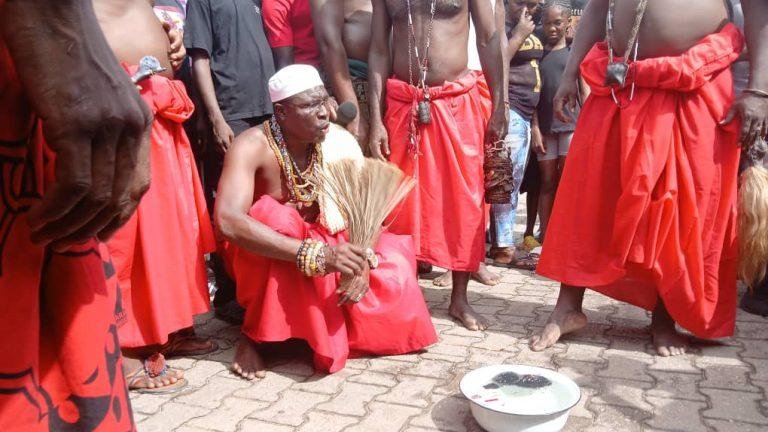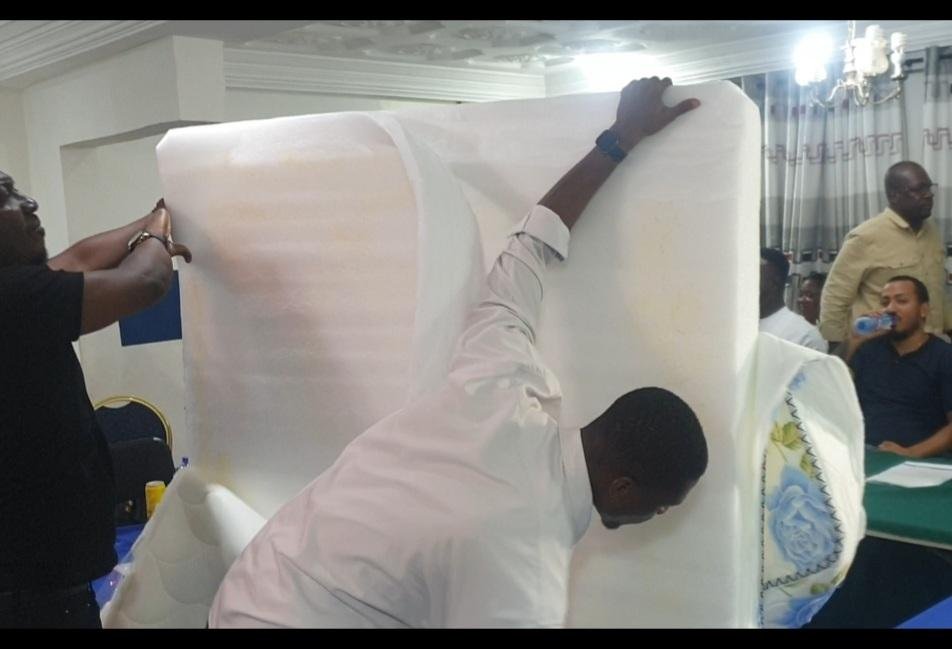News
Rich African culture, tradition on display at Asantehemaa funeral rites

The rain began at precisely 4:25 p.m. on Tuesday, September 16, 2025, the second day of the funeral rites of the late Asantehemaa, Nana Konadu Yiadom III.
In most places, such a downpour might have sent mourners scurrying for shelter, umbrellas snapping open like protective wings. But this was Manhyia Palace in Kumasi, and this was no ordinary farewell.
As thousands stood steadfast in the rain, their traditional black ‘Kuntunkuri’ garments darkening with moisture, something magical was about to unfold.
The Asantehene, Otumfuo Osei Tutu II, seated regally in his palanquin and surrounded by loyal chiefs, was being carried across the funeral grounds to greet his people who had come to honour his late sister, Nana Konadu Yiadom III.
Then came the moment. The bearers stopped at a point. The drums spoke their ancient language. And in a gesture that perfectly captured the soul of a kingdom, the king of the Asante people appeared ‘possessed’ in the palanquin and danced—gracefully, purposefully, powerfully—in the rain.

The crowd erupted. Cheers thundered across the palace grounds, mixing with the rhythm of traditional drums and the percussion of raindrops on umbrellas and rooftops.
Nana Konadu Yiadom III was no ordinary royal. Born in 1927 at the sacred Benyaade Shrine at Merdan, Kwadaso, Nana Ama Konadu was the daughter of Nana Afia Kobi Serwaa Ampem II, Asantehemaa from 1977 to 2016, and Opanin Kofi Fofie, a respected carpenter from Besease near Atimatim.
She lived for 98 remarkable years, serving as the 14th Asantehemaa—the Queenmother who stood not behind, but beside the king, wielding spiritual authority and political wisdom in equal measure. She ascended the stool on February 6, 2016.
On August 12, 2025, the Asantehene shared that the Queenmother had been remarkably active on the morning of her final day, attending to her duties with characteristic vigor before her sudden departure in the afternoon.
Her passing came just a day after the nation was plunged into mourning following a tragic military helicopter crash that claimed the lives of eight high-ranking government officials.
Her eight-year reign was marked by what those who knew her described as ‘quiet strength’ and ‘institutional wisdom.’
As elder sister to the Asantehene and guardian of the Oyoko lineage, she was far more than a ceremonial figure. The Asantehemaa nominates the next king, rules on disputes, and commands her own palace.
She is the keeper of matrilineal succession, the voice of ancestral guidance, and in times of crisis, even a war leader—as history remembers from Yaa Asantewaa’s legendary stand against British colonialism in 1900.
The late queenmother’s passing marked the end of a lineage stretching back to 1695, from Nana Nyarko Kusiamoa to the present day.
Some reigned for decades, like Nana Konadu Yiadom I (41 years) and Nana Afia Kobi Serwaa Ampem II (39 years), while others, like Nana Yaa Dufie and Nana Ama Serwaa I, held the stool for shorter but no less impactful tenures.
Each Queenmother brought her own gifts—some as fierce protectors of tradition, others as reformers and mediators. Together, they form what one historian called “a tapestry of Ashanti womanhood that stretches across centuries.”
Business
But, even in mourning, life finds a way to celebrate culture. Across the Palace, sales of mourning cloths, (Kuntunkuri), amulets, ‘Ahenema’—the traditional royal slippers also known as ‘Kyawkyaw’—have skyrocketed during the funeral rites.
‘Kyawkyaw’ are not mere footwear; they are cultural artefacts dating back to the 18th century, each pair telling a story through its symbols and colours.
The black funeral slippers bear names that sound like poetry: ‘Anibere a nso gya,’ ‘sika wo ataban.’ Each design reflects not just fashion, but identity, status, and occasion.
During the funeral, chiefs and queenmothers could be seen carefully polishing their Ahenema, preparing to honour their departed matriarch in proper traditional style.
Traders told local media that while sales were always steady, the funeral has brought unprecedented demand. “Everyone wants to pay their respects properly,” explained one vendor.
The four-day funeral, running from September 14-18, has transformed Kumasi into a cultural epicentre drawing dignitaries from across Ghana and beyond.
To ensure dignified and orderly participation, the Palace designated specific days for various institutions and groups to pay their respects.
Monday, September 15, was reserved for churches and clergy, political parties, educational institutions, non-governmental organisations, telecommunication firms, corporate bodies, recognised associations, and the general public.
Tuesday, September 16, would welcome the Judiciary and Ghana Bar Association, security services, including the Ghana Armed Forces, Police, Fire Service, Prisons Service, Immigration, and Customs, alongside State-Owned Enterprises, public officers, financial institutions, and the general public.
Wednesday, September 17, was designated for Ministers of State, the Diplomatic Corps, Members of Parliament, Metropolitan, Municipal and District Chief Executives, non-Asante chiefs, mining companies, and the general public.
Spiritualists and traditional groups from across Africa set the tone for day three of the funeral rites of the late Asantehemaa, with striking rituals and cultural displays.
Delegations from Benin and Togo amazed mourners with sacred performances featuring revered deities, offering a rare glimpse into their deep-rooted customs.
The people of Aflao also held the crowd spellbound with a dramatic ritual that saw flames rising from water in a vessel — a symbolic act that stirred awe and excitement among onlookers.
A mourner who witnessed, told The Spectator: “This is not something you see every day. It is a reminder of how African traditions, though varied, can come together under the influence of the Asante Kingdom.”
Speaking to The Spectator a cultural commentator at the event observed, “The Asantehemaa’s funeral is more than mourning. It has become a showcase of Africa’s cultural richness, demonstrating the power of tradition to unify people.”
Thursday, September 18, had the President, John Dramani Mahama, former Presidents and Vice Presidents, the Diplomatic Corps, and the general public.
Other Paramount Chiefs from beyond Ashanti such as Oguaamanhene Osaberima Kwesi Atta II, Paramount Chief of Sefwi-Anhwiaso, Ogyeahoho Yaw Gyebi III, The Ga Mantse, Paramount Chief of Aflao, Torgbi Amenya Fiti V, among others, were all not left out to mourn with the Asantehene.
As the sacred process of selecting the 15th Asantehemaa begins, with the Oyoko clan deliberating under ancestral guidance, one image will remain: their king, dancing in the rain, showing that true majesty is not about staying dry—it is about being present, authentic, and connected to your people, regardless of the weather.
From Kingsley E. Hope
News
Watch your mattresses!…they can cause chronic back pain, other health disorders

Local mattress manufacturers have raised serious concerns over the influx of substandard mattresses, warning that these products pose significant health risks to consumers and threaten the sustainability of Ghana’s mattress industry.
At a press briefing held in Kumasi on Tuesday, manufacturers accused unregistered foreign entities, particularly Chinese firms, of flooding the market with cheap mattresses made from polystyrene.
Mr Yaw Ampem Darko, a spokesperson for the local manufacturers, warned that prolonged use of substandard mattresses, especially those made with polystyrene, could result in chronic back pain, musculoskeletal disorders, poor posture, and diminished sleep quality.
These health implications, they stressed, were not always immediately evident but accumulate over time, especially among vulnerable populations such as children and the elderly.
This material, typically used for packaging, is considered unsuitable and unsafe for bedding.
According to industry leaders, these sub-standard products have been circulating for at least five years, gaining traction among unsuspecting consumers due to their unusually low prices.
“These mattresses are being sold at suspiciously low prices, luring unsuspecting consumers who are unaware of the health dangers.”
“We are not just protecting our businesses; we are protecting Ghanaian lives. The government must act swiftly to stem this tide before more citizens fall victim to these dangerous products,” Mr Yaw Ampem Darko stated.
The Ghana Standards Authority (GSA) has acknowledged the issue and, in response, announced a nationwide enforcement campaign aimed at clamping down on the production, distribution, and sale of substandard mattresses.
The campaign, which was scheduled to take effect from September 30, 2025, was empowered by the GSA Act, 2022 (Act 1078), which authorises the Authority to seize and seal non-compliant products and impose sanctions on offenders.
In a statement signed by the Director General of the GSA, Professor George Agyei, the authority cited Sections 29 and 43 of the Act, reiterating that all mattresses sold in Ghana must meet established national standards or face confiscation.
The statement further emphasised that mattresses failing to meet these standards not only compromise sleep quality but also contribute to long-term health complications, including spinal and neck pain.
Despite the GSA’s commitment, manufacturers have expressed frustration over delays in implementation and called for stronger enforcement mechanisms.
They urged the GSA to work in close collaboration with the Customs Division of the Ghana Revenue Authority and national law enforcement agencies to identify and prosecute violators of Ghana’s quality standards.
Manufacturers are also appealing to consumers to remain vigilant and prioritise their health by verifying that any mattress they purchase bears the GSA certification mark.
Moreover, they caution the public against purchasing suspiciously cheap mattresses that lack proper labelling or identifiable branding, as these were often indicators of substandard or counterfeit products.
As the official enforcement deadline had expired with no show, the local producers insisted that much more than business interests were at stake.
They argued that without swift and sustained action, the health and safety of Ghanaian consumers would continue to be compromised.
“Public awareness, strict enforcement, and collaboration among regulatory bodies are essential if we are to protect the integrity of the local industry and the wellbeing of the Ghanaian people,” Mr Darko indicated.
From Kingsley E. Hope, Kumasi
Join our WhatsApp Channel now!
https://whatsapp.com/channel/0029VbBElzjInlqHhl1aTU27
News
Raissa Initiative demands harsher punishment for sexual abusers of girls

The Founder of the Raissa Child Protection Initiative, Ms Raissa Sambou, has urged authorities to impose severe punishment on individuals, including teachers and guardians, who sexually abuse young girls.
Speaking in an interview to mark this year’s International Day of the Girl Child (October 11), Ms Sambou condemned the increasing cases of sexual exploitation involving minors, describing such acts as “heartless, criminal, and a total betrayal of trust.”
She noted that those entrusted with the care and education of children must not be the same people who violate them, stressing that “anyone found guilty of abusing a girl child must face the full rigours of the law without leniency.”
The International Day of the Girl Child is observed annually to promote the rights of girls, empower them to reach their full potential, and draw attention to the challenges they face worldwide.
Ms Sambou lamented that poverty continues to push many young girls into vulnerable situations, exposing them to exploitation.
She expressed concern that some headmasters, teachers, and community members who should protect girls rather take advantage of them.
“This must stop immediately. The safety of every girl must never be compromised,” she said, urging the public to report all forms of abuse to the appropriate authorities and called for swift action by law enforcement agencies against perpetrators.
Addressing girls directly, Ms Sambou encouraged them to take their education seriously and to believe in their potential.
“It is possible to be young and responsible. Your future is bright, protect it, believe in it, and never let anyone dim your light,” she advised.
She further urged girls to choose their friends wisely, stay disciplined, and speak up if anyone makes sexual advances toward them.
Ms Sambou concluded with a rallying call for collective action, saying “speak up, protect them, and empower them. Together, we can end the sexual exploitation of girls.”
By Esinam Jemima Kuatsinu
Join our WhatsApp Channel now!
https://whatsapp.com/channel/0029VbBElzjInlqHhl1aTU27














